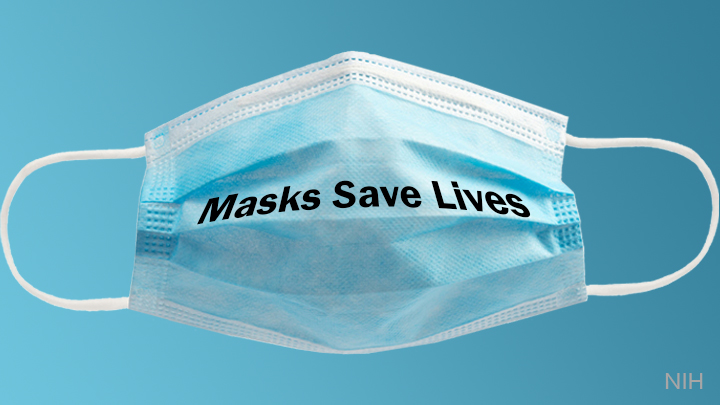
Masks Save Lives
Posted on by Dr. Francis Collins

Reminding others that “masks save lives” isn’t just sound advice. It’s a scientific fact that wearing one in public can help to slow the spread of SARS-CoV-2, the virus responsible for the coronavirus disease 2019 (COVID-19) pandemic.
I’m very careful to wear a mask outside my home whenever I’m out and about. I do it not necessarily to protect myself, but to protect others. If by chance I’ve been exposed to the virus and am currently incubating it, I wouldn’t want to spread it to other people. And any of us could be an unknowing superspreader. We owe it to everyone we encounter, especially those who are more vulnerable, to protect them. As my NIH colleague Tony Fauci recently demonstrated , it’s possible to wear your mask even while you’re outside exercising.
But there are still skeptics around. So, just how much does a facial covering protect those around you? Quite a bit, according to researchers who created a sophisticated mathematical model to take a more detailed look [1]. Their model shows that even if a community universally adopted a crude cloth covering that’s far less than 100 percent protective against the virus, this measure alone could significantly help to reduce deaths.
These findings, funded partly by NIH, were published recently in Nature Communications. They come from Colin Worby, Broad Institute of MIT and Harvard, Cambridge, MA, and Hsiao-Han Chang, National Tsing Hua University, Taiwan.
The researchers noted several months ago that recommendations on wearing a mask varied across the United States and around the world. To help guide policymakers, the researchers simulated outbreaks in a closed, randomly interacting population in which the supply and effectiveness of crude cloth or disposable, medical-grade masks varied.
Under different outbreak scenarios and mask usages, the researchers calculated the total numbers of expected SARS-CoV-2 infections and deaths from COVID-19. Not surprisingly, they found that the total number of deaths and infections declined as the availability and effectiveness of face masks increased.
The researchers’ model primarily considered the distribution of medical-grade, surgical masks. But because such masks are currently available in limited supply, they must be prioritized for use by health care workers and others at high risk. The researchers go on to note that the World Health Organization and others now recommend wearing homemade face coverings in public, especially in places where the virus is spreading. While it’s true the ability of these face coverings to contain the virus is more limited than medical-grade masks, they can help and will lead to many fewer deaths.
Another recent paper also suggests that while wearing a mask is primarily intended to prevent the wearer from infecting others, it may also help lower the dose, or inoculum, of SARS-CoV-2 that the wearer might receive from others, resulting in milder or asymptomatic infections [2]. If correct, that’s another great reason to wear a mask.
Already, more than 175,000 people in the United States have died from COVID-19. The latest estimates [3] from the Institute for Health Metrics and Evaluation (IHME) at the University of Washington’s School of Medicine, Seattle, predict that the COVID-19 death toll in the U.S. may reach nearly 300,000 by December 1.
But that doesn’t have to happen. As this new study shows, face coverings—even those that are far from perfect—really can and do save lives. In fact, IHME data also show that consistent mask-wearing—starting today—could save close to 70,000 lives in the months to come. Saving those lives is up to all of us. Don’t leave home without your mask.
References:
[1] Face mask use in the general population and optimal resource allocation during the COVID-19 pandemic. Worby CJ, Chang HH. Nat Commun. 2020 Aug 13;11(1):4049.
[2] Masks Do More Than Protect Others During COVID-19: Reducing the Inoculum of SARS-CoV-2 to Protect the Wearer . Gandhi M, Beyrer C, Goosby E. J Gen Intern Med. 2020 Jul 31.
[3] New IHME COVID-19 forecasts see nearly 300,000 deaths by December 1 . Institute for Health Metrics and Evaluation. August 6, 2020.
Links:
Coronavirus (COVID-19) (NIH)
Colin Worby (Broad Institute of MIT and Harvard, Cambridge, MA)
Hsiao-Han Chang (National Tsing Hua University, Taiwan)
NIH Support: National Institute of Allergy and Infectious Diseases






















.png)











No hay comentarios:
Publicar un comentario